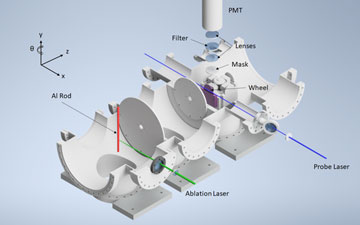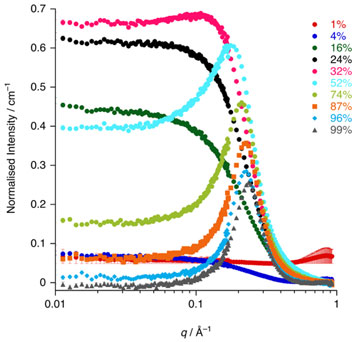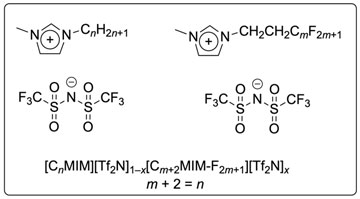Synthesis and Properties of Ionic Liquids for Application in Supported Ionic Liquid Phase (SILP) Catalysis
Scientific background
Ionic liquids (ILs) are molten salts with low melting temperatures, typically composed of complex ions. Archetypal examples are the 1-methyl-3-alkylimidazolium salts shown below. They have been of considerable interest in recent years due to their unique combination of physical properties, including low vapour pressures, inherent conductivity, often high chemical and thermal stability, and their ability to dissolve a range of solutes of differing polarity. They have been investigated for their potential use in a wide range of areas including catalysis, biomass processing, carbon capture and storage (CCS), and various energy technologies.
Supported ionic liquid phases (SILPs) represent a proven strategy for catalysis. SILPs comprise a thin ionic liquid (IL) film deposited on a high-surface-area support (eg porous silica), in which a homogeneous catalyst can be dissolved producing an effectively heterogenised arrangement. The high surface area of the support and the heterogenised nature of the catalyst coupled with the selectivity of its homogeneous mode of action makes SILPs highly effective materials with demonstrated effectiveness and even greater potential yet to be realised. While much is understood from organometallic chemistry on how the action of metal complexes may be optimised, the rational optimisation of ILs for application in SILPs, based on a detailed understanding of their structure and properties, is much less developed. For example, particular ILs may promote the permeability and/or solubility of a particular gaseous reagent, while tailoring the local environment in the SILP could promote a particular mode of catalyst action. From this point of view, the almost infinite tunability of ILs and their properties through choice of cation and anion makes them attractive in this context. Yet it is exactly that huge number of potential materials that prohibits the making and testing of vast numbers of individual ILs to find the perfect liquid for the desired application. This issue is addressed effectively by preparing IL mixtures, where properties can be tuned smoothly in mixtures created from a much smaller number of starting ILs. Components can be made quickly and then used to generate a large range of mixtures in which the physical properties and the interfacial and bulk structures may be tuned.
The approach
Through a long-standing collaboration supported by EPSRC grants (EP/K032062/1, EP/T031174/1 and EP/T03114X/1), the groups of Slattery and Bruce (York - UoY) and McKendrick and Costen (Heriot Watt - HWU) have been investigating mixture of ILs.

Schematic diagram of the experimental chamber for Al-atom experiments.
The extremely low volatility of ILs makes them ideal for study by reactive atom scattering – a surface technique pioneered by the HWU group and long-term collaborator Minton (Colorado, USA). Using beams of oxygen atoms allows the abstraction of surface hydrogen atoms to form OH radicals that are detected by laser-induced fluorescence (reactive atom scattering coupled with laser-induced fluorescence – RAS-LIF), which has facilitated the study of the surfaces of IL mixtures. More recently, an analogous experiment has been developed that uses a beam of Al atoms, which are capable of abstracting surface F atoms as AlF, then subsequently also detected by LIF. These two methods are then highly complementary in the study of the surfaces of mixtures where one component has a hydrocarbon chain, while the other has a fluorocarbon chain. The data obtained from these experiments are then complemented by data from surface tension experiments as well as neutron reflectometry.

Small-angle neutron scattering (SANS) data for mixtures of long- and short-chain ionic liquids
Further information derives from the study of the bulk structure, which is undertaken using small-angle X-ray (SAXS) and neutron (SANS) scattering as well as the evaluation of other bulk properties such as viscometry and conductivity. All of this work benefits significantly from atomistic molecular dynamics simulations in-house at HWU and externally from Shimizu and Canongia Lopes in Lisbon.
Progress
Studies have concentrated on two main families of mixtures as shown below.

All-hydrocarbon ionic liquids for use in mixture studies.
In this first series, it was found that in mixtures where n = 12 and m = 2 (alongside), the longer-chain IL concentrated preferentially at the surface. In addition, a range of mixtures where n and m were varied between 2 and 12 were prepared and studied by small-angle scattering, which among other things gave information on the onset and persistence of percolation as a function of chain length and composition.

Ionic liquids bearing hydrocarbon or fluorocarbon chains for use in mixture studies.
A second and ongoing series of experiments is considering the mixtures alongside where one component has a hydrocarbon chain and the other a semiperfluorocarbon chain. O-Atom RAS-LIF showed reduced coverage by hydrocarbon chains (lower yield of OH LIF) pointing to preferential concentration of the fluorocarbon-based IL at the surface, an observation supported by surface tension measurements.
Because certain gases are preferentially soluble in fluorocarbon over hydrocarbon media, knowing that the fluorocarbon concentrates at the surface informs the use of such mixtures where gaseous reagents are used. This surface work has been complemented by small-angle scattering studies of the bulk, which show that for n = 8, the two materials are continuously miscible with no evidence for phase separation nor triphilic behaviour.
SILP catalysis
SILP catalysis is an extremely promising field of activity with groups looking at both homogeneous and nanoparticle-based systems. Use of porous supports leads to high surface areas and also heterogenises the IL so that catalyst separation is readily facilitated. There are significant research centres for this work in Erlangen, Aachen and Copenhagen.
Very recently, working with the Erlangen group we have investigated rhodium-catalysed, homogeneous hydrogenation of ethene using mixtures of hydrocarbon ILs and their pure components, as well as mixtures of hydrocarbon and fluorocarbon ILs, again alongside their pure components. The results, which will be presented at the meeting, are extremely promising and we are currently engaged in delineating the different factors at play in determining the reactivity.
Contact us
For any further details, please contact either Duncan Bruce or John Slattery.
